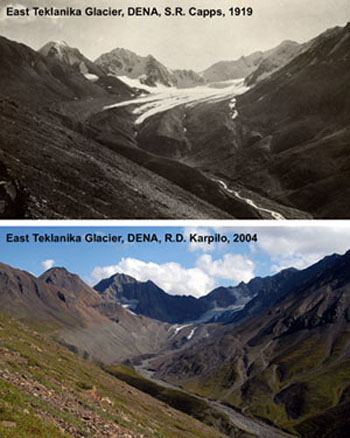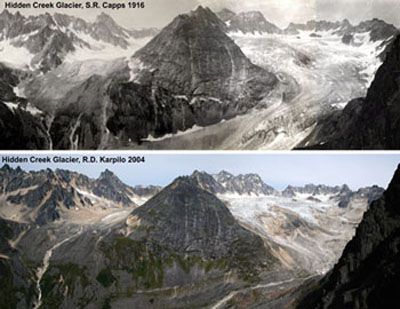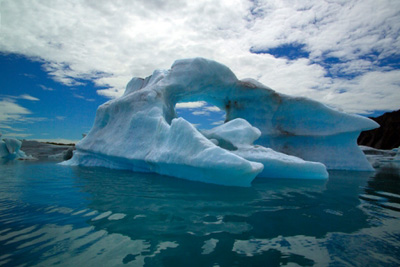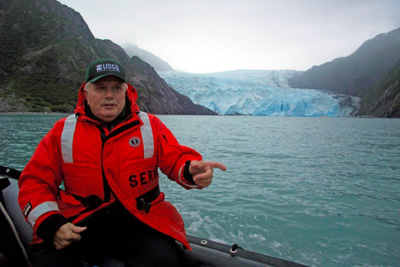
Global warming brings changes to parks
Massive glaciers reduced to puddles, thousands of acres of trees are dead as they stand, and what, if anything, can we do about it?
Maybe nothing.
Whether increase in temperature is caused by human activity or natural earth cycles, the national parks in Alaska are experiencing environmental problems, even disasters, and some could endanger wildlife, ecosystems and human lives.
“Within our parks, there have been a number of people doing climate change-related research and related projects,” said John Quinley, the National Park Service Alaska Region public information officer.
| A cross country hiker in Denali National Park in Alaska (Photo courtesy of the National Park Service). |  |
One of these people is Pam Sousanes, an environmental specialist who works primarily in Denali National Park. She also does research in Wrangell-St. Elias National Park and Preserve and in Yukon-Charley Rivers National Preserve.
“Climate monitoring is part of a larger effort to improve park management through greater reliance on scientific knowledge,” Sousanes said.
Sousanes’ most recent work has been with the parks mentioned above, which account for 21 million acres of protected land. This amounts to 25 percent of the entire area of the NPS.
In an oral report she made at that 2006 Alaska Park Science Symposium, Sousanes explained how the focus has mostly been on the northern-most parks, because data have shown the effects of changing climate have been noticeable.
 |
Comparison pictures of glaciers only 85 years apart show impressive differences. The top picture was taken in 1919 and the bottom picture was taken in 2004. (Top photo courtesy of the U.S. Geological Survey. Bottom photo courtesy of the National Park Service). |
“Smoke-filled summer skies, earlier green-up in spring and record warm winter and spring temperatures are just a few of the recent climate observations,” Sousanes wrote in the abstract of her presentation.
The effort the NPS is putting forward is not to cure the earth’s global sickness, but to understand it further. Better climate monitoring will lead to better park management and a better understanding of the “dynamic nature and condition of the parks,” said Sousanes.
Bruce Molnia, a research geologist, studies some of the glaciers in Alaska by photographing them repeatedly over time. Through this, he can gain concrete evidence of the glaciers receding. Molnia is an avid believer of climate change.
“Is it happening? The answer is without question. If it is why it is happening,” Molnia said, “then that is another question.”
He spoke of how the greenhouse effect certainly are trapping more heat in the atmosphere then they used to, but he is not convinced that this is the major reason, or the only reason that climate is changing.
 |
Another set of comparison pictures show dramatic change between 1919 and and 2004. (Top photo courtesy of the U.S. Geological Survey. Bottom photo courtesy of the National Park Service). |
“The reality is that the glaciers have come and gone in the last 100 million years,” Molnia said, “some glaciers existed 12000 years ago and disappeared 7000 years ago”
This fact contradicts the many opinions that Earth is changing only because of carbon emissions. These melting glaciers do have immediate effect on nature, however.
“Based on my observations, where the glaciers are melting they are being replaced by vegetation. With the vegetation comes both insects and mammals, and in the case of the fjords the populations of the seals, fish, and whales,” said Molnia.
This is happening very rapidly. However, the addition of vegetation is not the largest concern among researchers.
Quinley touched upon the issue of dying spruce trees at the expense of a parasitic beetle that feeds on the bark.
“One of the things that regulate the beetles,” Quinley said, “is how warm the summer is and how cold the winter is. The trends have regulated an explosion of beetles.”
The beetle problem began 10 to 15 years ago and mostly occurs outside of the national parks. However, if the warming trend continues, the beetles may be able to infect the spruce trees in the more northern parks.
The deforestation has affected many aspects of park life.
 |
An iceberg floats in Bear Glacier Lake, Kenai Fjords National Park. Bear Glacier is undergoing a rapid retreat (Photo courtesy of Bruce Molnia). |
“There certainly has been a big change in landscape there,” Quinley said, referring to Kenai National Park.
Landscape is not the only aspect of the parks being affected by trees dying. There are serious brush fire implications and a lot of trails need to be cleared of fallen trees, requiring a lot of manpower and funds. Animals that use the trees as part of their habitat are also affected.
The cause of the climate shift in Alaska has not been proven and no acceptable solutions have been proposed. Over the past 82 years, the average temperature in Denali National Park has been in fluctuation, in chunks of two to three decades.
“Some of this variability can be explained by the Pacific Decadal Oscillation,” Sousanes said, “which is a pattern of Pacific climate variability that shifts phases on a multi-decadal time scale, usually about 20 to 30 years.”
This evidence of natural climate variation is a change of pace from the usual accusations that human activity is to blame for heating our planet.
“As for warming, there have been changes,” said Kris Fister, Denali National Park media director. “Time will tell, as we continue to gather data, if it is a shorter more cyclical thing or more of a long-term issue.”
Fister’s lack of urgency is just a step back to look at the bigger picture. It is a chance to gather more data and try to make a better stab at figuring out this warming, melting and other phenomenon.
For more information about the Alaskan national parks visit http://www.nps.gov/akso/
GLOBAL WARMING TIMELINE
| 1925-45 | Warming period |
| 1946-77 | Cooling period |
| 1977–2007 | Current warming period |
| There was a major shift in temperatures from the cooler period to the current warm period. |
Source: Pam Sousanes
|
 |
Dr. Bruce Molnia conducts research near Holgate Glacier in Kenai Fjords National Park in Alaska. (Photo courtesy of Bruce Molnia). |
WARMING WARNINGS AT NATIONAL PARKS OF MOST RISK
|
PARK AND |
Fire |
Fishing |
High- |
Historic |
Plant |
Snow- |
Wild- |
Winter |
|
Death |
Y |
Y |
Y |
|||||
|
Glacier |
Y |
Y |
Y |
Y |
Y |
Y |
Y |
|
|
Grand |
Y |
Y |
Y |
Y |
Y |
Y |
Y |
|
|
Mesa |
Y |
Y |
Y |
|||||
|
Mount |
Y |
Y |
Y |
|||||
|
North |
Y |
Y |
Y |
Y |
||||
|
Rocky |
Y |
Y |
Y |
Y |
Y |
Y |
Y |
|
|
Yellowstone |
Y |
Y |
Y |
Y |
Y |
Y |
Y |
|
|
Yose- |
Y |
Y |
Y |
Y |
Y |
Chart source: Consumer Reports, June 2007. Chart information taken from Losing Ground, Rocky Mountain Climate Organization and the Natural Resources Defense Council, July 2006.

Comments are Closed